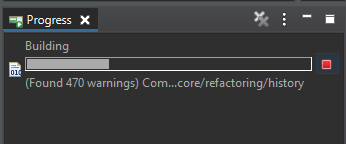Platform and Equinox API
Platform Changes |
|
| JFace ImageDescriptor supports alternative naming scheme for high dpi |
Currently This can rapidly increase the number of images required if multiple resolutions are used as there are duplications (e.g. 16x16@2x is the same as 32x32 icon). The second limitation is that only two fixed zoom levels are supported at the moment. It is now possible to use an alternative naming scheme where icon resources are organized in folders holding the resolution in folder-name (e.g. icons/16x16/icon1.png, icons/32x32/icon1.png and so on). This also has the advantage that it is possible to use other scaling factors beside the 150/200% that are currently supported. |
| Slicing Support for IProgressMonitor |
Previously it was possible to split a
To overcome this limitations a new way of slicing a monitor was added
For further details on usage, check the javadoc of the new method. |
| IAdapterFactory as Service |
Previously From now on it is possible to also register an OSGi Service for this purpose and thus can take advantage of Declarative Services for example or even specialized construction and registration with plain OSGi mechanism.
The service must only supply a string property (or even multiple ones) with |
| IDialogSettingsProvider |
The org.eclipse.jface.dialogs.IDialogSettingsProvider is a new interface
to describe classes that are responsible for loading and saving IDialogSettings.
Clients can now provide a central place to manage dialog settings.
|
| PlatformUI dialog settings |
PlatformUI.getDialogSettingsProvider(Bundle) has become the central place
for getting bundle based dialog settings.
All methods in AbstractUIPlugin dealing with dialog settings have been deprecated.
|
| CompositeFactory support layout supplier |
CompositeFactory now supports the usage of a layout supplier for each new composite.
CompositeFactory.newComposite(SWT.NONE).supplyLayout(GridLayoutFactory.fillDefaults()::create).create(parentComposite);
|
| New DateTimeFactory |
DateTimeFactory is available to create DateTime widgets.
|
| JFace Util method to check if widget can be used |
The new static utility org.eclipse.jface.util.Util.isValid method allows to check if a widget is null or disposed.
|
| Generic Unit Test View and extension point |
A generic Unit Test view was added in a new org.eclipse.unittest.ui plugin.
It allows extenders to add support for reports and management of test executions in any test engine through
a common view, by adding an extension to
org.eclipse.unittest.ui.unittestViewSupport extension point for the specific test engine.
Extensions typically deal with receiving input from an The Examples of consumers are:
|
| Lines visible CSS option |
Visibility of lines in trees and tables can now be configured using the swt-lines-visible CSS property.
Here's how it looks when lines are disabled in the dark theme on Windows:
|
SWT Changes |
|
| Windows dark theme styles progress bars |
The progress bar in the dark theme on Windows OS is now styled:
On Windows 10, all the dark theme tweaks including the dark progressbar can be disabled using the
-Dorg.eclipse.swt.internal.win32.disableCustomThemeTweaks=true |


